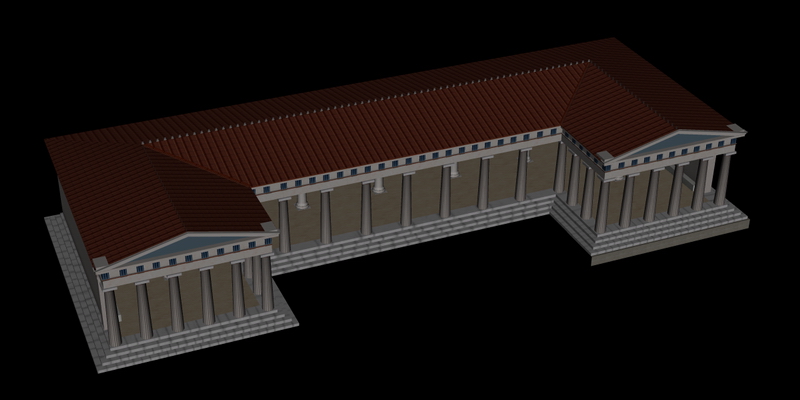This building is present in the Agora throughout the three phases represented (Classical, Hellenistic, Roman). In effect, there are two construction phases: the first, dating to 430-420 BC and involving the building’s erection and continued until the Augustan era, and the second, which includes the addition of two rooms behind the stoa, built in Augustus’ reign. Although many architectural members of this building were relocated in the 5
th cent. BC, enough remain to allow for a certain representation. This is a Pi-shaped Doric structure with prevalent wings and 25 Doric columns, made of Pentelic marble and featuring an internal Ionic colonnade. The only contested feature is the arrangement of the columns in the centre: the excavators have tentatively posited an intercolumniation larger than the usual 2.01m which occurs in the edges. This intercolumniation, however, is thought undersized for the entrance of such an important edifice [Thompson, H.A., ‘Buildings on the West Side of the Athenian Agora’,
Hesperia 6 (1937), pp. 21-47]. Nonetheless, in the published pictorial representations of the building, the central intercolumnal distances are equal to the lateral ones [Μc Camp II, J.,
The Athenian Agora, A Short Guide to the Excavations,
Excavations of the Athenian Agora, Picture Book no 16, American School of Classical Studies (Princeton 2003), p. 9], and this is the solution we employed. The decoration is accurately represented, following the identification of the members discovered in 1970 in an adjacent Byzantine building, as suggested by the excavators [Thompson, H.A. – Wycherley, R.,
The Agora of Athens. The American Excavations in the Athenian Agora, vol. XIV, American School of Classical Studies at Athens (Princeton 1972), pp. 96-103]. The acroteria are represented tentatively.

Stoa of Zeus Eleutherios, 3D representation, Classical period

Stoa of Zeus Eleutherios, 3D representation, Roman period

